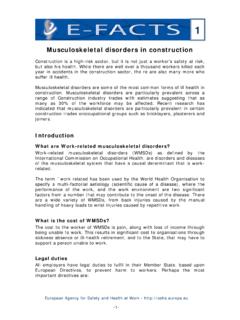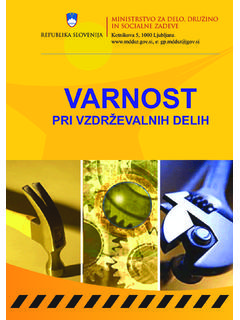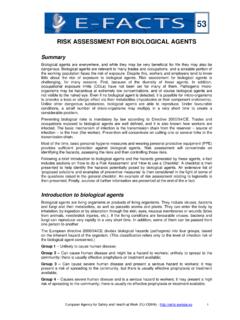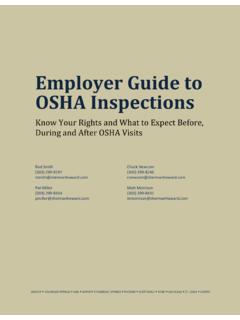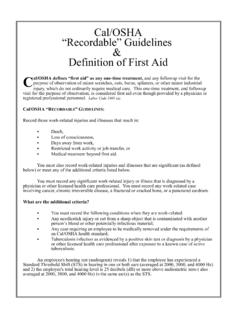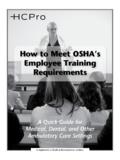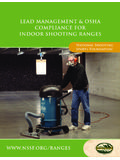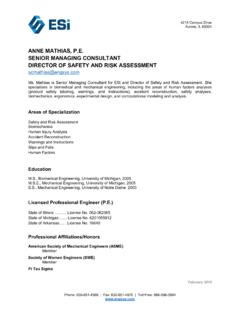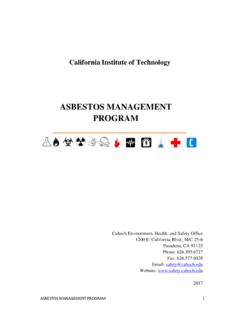Transcription of E-fact 35: Risk Assessment for Care Workers
1 35. Risk Assessment for care Workers Summary The principal objective of home care is the provision of support to enable service users to be cared for in their own home for as long as possible, or to enable them to return to their own home from hospital or other accommodation.[1] Home care Workers assist people at home, allowing them to stay in their homes, rather than use residential, long-term, or nursing care institutions. care Workers visit users to help with daily tasks, and assist in their physical personal needs and in the follow-up of medical plans. This article provides practical information on these activities to employers of care Workers , as well as care Workers and their representatives.
2 Following a brief introduction about home care Workers and OSH in care worker activities, the article includes sections on How to do a Risk Assessment ' and How to use a Checklist'. A general checklist is then presented to help determine Does the hazard exist at the workplace?'. An extensive list of Proposed solutions and examples of preventive measures' is then considered, for the different questions posed in the general checklist. A. case study is then presented, showing how appropriate education and training and the use of risk Assessment tools and a resource guide can alter a home care worker 's perception of occupational safety and health issues and through this reduce the potential for injuries and claims.
3 Finally, sources of further information are presented at the end of the article. Introduction to the home care sector With its ageing population, the European Union is experiencing an increasing demand for care services. The care sector in Europe is economically very significant, offering job opportunities for an estimated 10% of the workforce.[2] care Workers often have job titles such as Aged care worker , Disabled Carer, Domestic Helper, Home care worker and Residential care worker Adults. The essential point is that they work in private homes, assisting people who are unable to care for themselves or their families because of sickness, disability or old age.
4 care includes activities such as transportation, house cleaning, personal hygiene, providing meals, and other activities. Home care Workers ensure that those who require care can continue to live in their homes and in the community. Home care Workers may perform different groups of activities: Assisting with the physical personal needs of older, ill or disabled people, personal hygiene (bathing, dressing, using the toilet), lifting, transferring, moving, dressing, exercising, feeding and helping European Agency for Safety and Health at Work - -1- Risk Assessment for care Workers clients with mobility (these activities are also known as ADL activities of daily living).
5 Assisting in the follow-up of medical plans and instructions, involving physiotherapy or handling aids to daily living, such as incontinence supplies, diabetic meters and supplies, urological supplies, ostomy supplies, wound care supplies, equipment, gloves, mobility aids, nutrition, orthopedics, skin care products and supplies, vascular care products, blood tests and blood pressure monitoring. Assisting in the home environment and domestic duties, light housework (vacuuming, cleaning, washing and maintaining a tidy and safe environment), preparing meals, serving, help with eating and clearing away, and taking medications.
6 Assisting in the external needs of the person who requires care , such as shopping for groceries or clothes, using the telephone, managing money, going on scheduled outings ( transporting clients to appointments and activities), arranging social activities and shopping trips, and accompanying people on outings. Assisting in meeting psychosocial needs, for example by providing companionship, friendship and emotional support and managing problems related to dementia, and Interacting with family members and other supports to ensure that care needs are identified and met. To adequately develop all these activities, the home care worker requires a diverse knowledge ( familiarity with aids and equipment for daily living), particular skills (good communication) and personal attributes (compassionate and understanding, caring and supportive, flexible, adaptable, able to work in a variety of settings, respect cultural differences).
7 And be able to work independently with little supervision.[3]. Home care working conditions may have an impact on the carer's wellbeing and on the attractiveness of the working sector. The most important aspects of working conditions for carers are working hours, employment status and pay.[2] Physical and emotional strains and stresses, irregular working hours, heavy reliance on part-time and short-term contracts and geographical and professional isolation are some of the circumstances that may affect the health and safety of carers.[2] The high proportion of women in the European social care workforce and the perception that the skills associated with care provision are largely restricted to women, possibly influence the pay offered by the sector.
8 [2] care Workers earn less than other comparable occupational groups.[2] Rates of turnover in the sector are high ( in Germany, 80% of the social care workforce leave their job within five years). Levels of part-time employment are also higher for all carers than for total employment in every EU country. [2] In Spain, very few people have a 35- hour weekly contract.[4]. European Agency for Safety and Health at Work - -2- Risk Assessment for care Workers Introduction to OSH in care Workers ' activities Home care may represent a safety challenge for care Workers travelling between, and working in, patients' homes.
9 Injuries resulting from road traffic accidents, overexertion (and repetitive movements) when assisting patients and slips, trips and falls inside and outside their homes are the main causes responsible for lost working time among care Workers .[5]. Other causes of accidents and diseases in care Workers include exposure to hazardous chemicals (caustic, irritant, toxic or allergenic substances), being struck by objects, assaults and violent acts or behaviour. Additionally home care Workers may be exposed to infectious diseases (hepatitis, HIV, influenza (flu), tuberculosis (TB), measles, and chicken pox) when providing direct client care , such as dressing or bathing, or cleaning and cooking for infected clients.
10 [5][6]. Different conditions may also lead to mental or emotional fatigue in care Workers . Dealing with clients and family members who may be stressed and difficult to work with, and to work independently in unfamiliar and uncontrolled situations are examples of work situations that may cause stress to these Workers .[7]. All the above hazards may be present and identified during home care activities and must be taken into consideration in any risk Assessment of home care work. If these hazards are ignored then the result may well be accidents or health problems for home care Workers .

